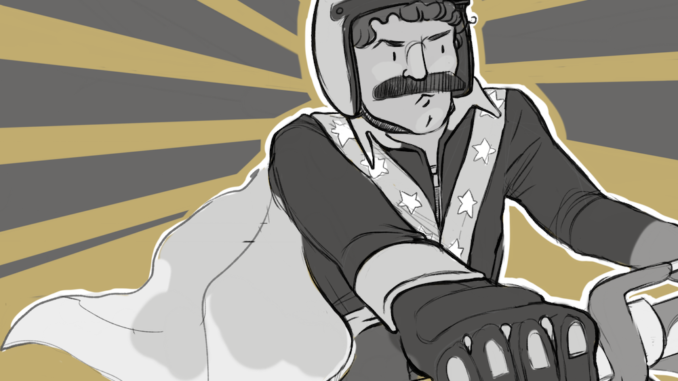
By Ray Freedman
With summer around the corner, there is a specific genre of film to keep in mind: the “hangout” movie. These movies are usually categorized as “comedies” or “ensemble comedies,” but they are a species of their own. The true beauty of these movies lies in how they allow the camera to rove around the characters. Even if there is a plot driving the film, the story cares more about how we get to know the characters, and how the movie allows us to wander around the story with them. Often dealing with the hazy paradox summer brings — excitement and freedom mixed with uncertain feelings of stagnancy, “hangout” movies are at their best when there is a loss of innocence involved. You watch the characters sink into a progression of their life. These movies want you to hang out with the characters, which makes them perfect for double features on a summer afternoon or evening. The double feature is an under-appreciated way of watching and sharing films. Like a playlist, it allows the audience to curate and make an event out of the art.
Two films that pair handsomely are Richard Linklater’s “Dazed and Confused” and F. Gary Gray’s “Friday.” Both regarded as classics from the ’90s, “Dazed and Confused” and “Friday” take place during less than 24 hours. The former depicts the last day of high school in 1976 Austin, TX, and the latter depicts a Friday in South Central Los Angeles. Featuring Matthew McConaughey, Parker Posey, Adam Goldberg and many others, Linklater’s film has an ensemble cast for the ages. Funny and eclectic, the personalities drift into summer with a spark that fills the film with kinetic energy. Gary Gray’s film, although silly at times, deals with more mature themes. Chris Tucker’s carefree, weed-loving Smokey plays perfectly alongside Ice Cube’s brooding, over-serious Craig. The film is able to craft a memorable depiction of stagnancy without adopting Craig’s seriousness — it is all fun. Although taking place in two different worlds, the film’s have similar tones. Beyond the universal hilarity of both films, their scenes to breathe the air of their worlds. One beautiful thing to notice in both films is the amount of times you can hear the background noise; you are left listening to the world with the characters. These moments sometimes last a couple seconds or less, but these are things that most films cut out for the sake of time. This attention to the time in between activity illuminates the aspect of not knowing what to do or what you are doing when you’re just hanging out with people.
If you’re in for a sillier, less mature double feature, there is always “Superbad” and “Hot Rod.” On the set of the former, there is a scene where McLovin’s sex scene is interrupted by his two new police officer friends which took a few takes to get right. The scene depicts Officer Slater (Bill Hader) angry at McLovin (Christopher Mintz-Plasse) for bailing on him to have sex with a girl, even though he has only known McLovin for one night. In an interview, Hader recounted that after a few takes, director Greg Mottola came up to him and gave him a note. “He’s your best friend,” Mottola said. Revealing the loneliness of his character. The scene is hilarious because of how serious it is for Officer Slater. I think this sincerity is why “Superbad,” and “Hot Rod,” have not aged at all since their release over a decade ago. Both films are incredibly silly, featuring ridiculous characters and plot lines, but are driven by the deep sincerity of the performances. In “Hot Rod,” director Akiva Schaffer and co. juxtapose this sincerity with absurdity. The film features a chaotic musical number featuring a whole town and has a scene where Rod (Andy Samberg) falls down a mountain for over a minute. While the film is tied to a simple plot, the film shines because of the small and extremely stupid exchanges. We laugh not only at the jokes but also at the fact that the jokes are happening.
Lastly, the genre has been mastered by, arguably, the two most iconic living American directors: Quentin Tarantino and Paul Thomas Anderson. Speaking on his friendship with Anderson, Tarantino has said it is his “most cherished relationship.” Around the time of the release of “Inherent Vice,” Anderson discussed a scene from “Jackie Brown” and its influence on him. Anderson describes the “compassion of the camera” in a scene where Jackie Brown and Max Cherry share a cup of coffee. “Jackie Brown” sees Tarantino at his most restrained, allowing his characters to feel their aging selves. There are few moments in all of cinema more compelling than Robert De Niro playing a stoned, washed up bank-robber struggling to hang up a telephone. It’s a beautiful moment, and this moment’s influence shows in “Inherent Vice.” Anderson’s Pynchon adaptation is a hangout movie disguised as a mystery-comedy. As Joaquin Phoenix’s stoner-detective tries to figure everything out, the camera is interested in floating around the mystery. It moves slowly, pushing in on the dialogue, only cutting away when absolutely necessary. We smoke weed with Phoenix’s character as the movie gets increasingly stoned. The mystery is not really relevant by the film’s end, and what is left is the feeling of the California breeze in the ’70s.
Subscribe to the Mossy Log Newsletter
Stay up to date with the goings-on at Lewis & Clark! Get the top stories or your favorite section delivered to your inbox whenever we release a new issue.

Leave a Reply